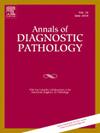Mucinous neoplasms associated with mature cystic teratomas: A clinicopathologic study of 50 cases: Are we ready for nomenclature change?
IF 1.4
4区 医学
Q3 PATHOLOGY
引用次数: 0
Abstract
Mucinous neoplasms associated with ovarian teratomas (MOvNTs) are uncommon with only a few large series published thus far. Their clinicopathologic features are evaluated in this multi-institutional study. Fifty MOvNTs were retrieved from the files of four institutions over 16-years (yr). Patient age, CEA and CA-125 levels, laterality, tumor size, type of mucinous tumor (according to gynecologic pathology criteria and proposed appendiceal nomenclature when applicable), immunohistochemistry (IHC), FIGO stage, presence of pseudomyxoma ovarii and peritonei, treatment, follow-up in months (mos), and outcome were recorded. Patients ranged in age from 17 years to 74 years (mean 43, median, 42). Increased CA-125 levels correlated with mucinous carcinoma and mucinous borderline tumor (p=0.0270), and CEA correlated with mucinous carcinoma (p=0.0256). Mucinous neoplasms were either cystadenomas (16), borderline tumors (20) or carcinomas (14). Forty-one were Mullerian/surface epithelial type and 9 were appendiceal-like. Using appendiceal nomenclature: Seven were low grade mucinous appendiceal neoplasms and 2 high grade appendiceal neoplasms. IHC: 39 % were CK20/CDX2/SATB2 positive and 61 % were CK7 > CK20 (+), and SATB2-. Almost all patients presented with FIGO stage I disease; except one each with FIGO II and IIIC disease. All patients had surgical resection, and 10 patients had adjuvant therapy. Recurrences occurred in 4 patients (range: 10–84 mos). At last follow-up (median 60 mos): 33 patients had no evidence of disease, 3 died of disease, 1 was alive with disease, 2 died of other causes, and 11 were lost to follow-up. MOvNTs are usually Mullerian/surface epithelial type and FIGO stage I. As the only patients with adverse outcome were those who had a diagnosis of mucinous carcinoma or microinvasive carcinoma, whether of appendiceal-like or Mullerian/surface epithelial type, using established gynecologic, rather than GI criteria for classifying all types of MOvNTs is recommended.
与成熟囊性畸胎瘤相关的黏液肿瘤:50例临床病理研究:我们准备好改变命名法了吗?
黏液性肿瘤合并卵巢畸胎瘤(MOvNTs)并不常见,迄今为止仅发表了几篇大型系列文章。他们的临床病理特征评估在这个多机构的研究。从4个机构16年的档案中检索了50份movnt。记录患者年龄、CEA和CA-125水平、侧侧性、肿瘤大小、黏液性肿瘤类型(根据妇科病理标准和拟议的阑尾命名法,如果适用)、免疫组化(IHC)、FIGO分期、卵巢和腹膜假性黏液瘤的存在、治疗、随访月数(最多)和结果。患者年龄从17岁到74岁(平均43岁,中位数42岁)。CA-125水平升高与黏液性癌和黏液性交界性肿瘤相关(p=0.0270), CEA与黏液性癌相关(p=0.0256)。黏液性肿瘤包括囊腺瘤(16例)、交界性肿瘤(20例)和癌(14例)。41例为苗勒管/表面上皮型,9例为阑尾样。使用阑尾命名法:7例为低级别粘液性阑尾肿瘤,2例为高级别阑尾肿瘤。IHC: CK20/CDX2/SATB2阳性39%,CK7 >阳性61%;CK20(+)和SATB2-。几乎所有患者均为FIGO I期疾病;FIGO II型和IIIC型各1例除外。所有患者均行手术切除,10例患者行辅助治疗。4例患者复发(范围:10-84例)。末次随访(中位60个月):无疾病证据33例,疾病死亡3例,带病存活1例,其他原因死亡2例,失访11例。MOvNTs通常为苗勒管/表面上皮型和FIGO i期。由于只有那些诊断为粘液癌或微创癌的患者出现不良结果,无论是阑尾样还是苗勒管/表面上皮型,建议使用既定的妇科标准,而不是GI标准来分类所有类型的MOvNTs。
本文章由计算机程序翻译,如有差异,请以英文原文为准。
求助全文
约1分钟内获得全文
求助全文
来源期刊
CiteScore
3.90
自引率
5.00%
发文量
149
审稿时长
26 days
期刊介绍:
A peer-reviewed journal devoted to the publication of articles dealing with traditional morphologic studies using standard diagnostic techniques and stressing clinicopathological correlations and scientific observation of relevance to the daily practice of pathology. Special features include pathologic-radiologic correlations and pathologic-cytologic correlations.

 求助内容:
求助内容: 应助结果提醒方式:
应助结果提醒方式:


